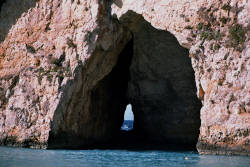Qaura
Inland Sea
Useful Information


| Location: |
Triq il-Ġebla tal-Ġeneral, San Lawarenz, Malta.
Dwejra Point is 5.5 km west of Victoria. Bus 91. (36.053769, 14.191082) |
| Open: |
no restrictions. [2025] |
| Fee: |
free. [2025] |
| Classification: |
 Sea Cave Sea Cave
 Collapse Doline Collapse Doline
|
| Light: | n/a |
| Dimension: | |
| Guided tours: | self guided |
| Photography: | allowed |
| Accessibility: | no |
| Bibliography: | |
| Address: | Inland Sea, Triq il-Ġebla tal-Ġeneral, San Lawarenz, Malta |
| As far as we know this information was accurate when it was published (see years in brackets), but may have changed since then. Please check rates and details directly with the companies in question if you need more recent info. |
|
History
Description

© Tony Oldham, 21-FEB-2002, with kind permission.
Just inland from the Azure Window is a large lake of emerald-coloured seawater surrounded by high limestone cliffs and linked to the sea via a narrow tunnel. Even in rough weather, the roomy shingle beach provides a sheltered spot for sun bathing. In calm weather, fishing boats can be hired for a trip through the tunnel to the Azure Window and caves in the adjoining cliffs. On the hills above are a series of caves which housed Malta’s earliest inhabitants. According to legend, a rich Gozo family lived in one of these caves during the Turkish invasion, and they remained there in safety until one of their own Turkish servants betrayed them to the enemy. The place is said to be near the top of the cliffs, but difficult to find.
Text by Tony Oldham (2002). With kind permission.
The cave connecting the Il-Qawra or Qaura (Inland Sea) with the Mediterranean was formed as a karst cave during the last cold phase of the Ice Ages. Blue clay is the foundation of the limestone, and is impermeable to the groundwater. The water flew above the impermeable layer towards the sea, using pre-existing fault lines and forming caves. When the climate became warmer, the ice caps and glaciers melted and the sea level rose worldwide, even in the Mediterranean. So the formerly normal karst cave was filled with seawater flowing into the cave from the lower end. A collapse of the ceiling, a doline, now forms the famous pool of seawater. It is one of the most famous diving spots on the island.
The outer entrance of the cave is narrow and close to the former natural bridge named Azure Window. A few years before this natural bridge collapsed and was completely destroyed, someone tried to widen this narrow section of the cave with explosives. Obviously, to allow bigger boats to cross the cave. However, the whole are is under nature protection and the explosives were illegal. According to some experts, the seismic waves caused by the explosions, may have weakened the already fragile natural bridge and lead to a faster collapse.
 Search DuckDuckGo for "Inland Sea"
Search DuckDuckGo for "Inland Sea" Google Earth Placemark
Google Earth Placemark OpenStreetMap
OpenStreetMap Atlantis Gozo Malta’s Diving Paradise (visited: 08-FEB-2025)
Atlantis Gozo Malta’s Diving Paradise (visited: 08-FEB-2025) Index
Index Topics
Topics Hierarchical
Hierarchical Countries
Countries Maps
Maps